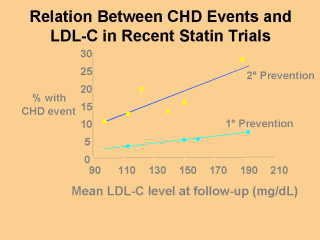 |
Relation Between CHD Events and LDL-C in Recent Statin Trials
Recent trials of the statins, which have included data from
30,817 patients in total, have demonstrated a near linear relation between LDL-C
levels and CHD events.
Data from primary-prevention studies (WOSCOPS) and
secondary-prevention studies (CARE, 4S) demonstrate that lowering LDL-C levels results in
fewer CHD events.
Data from two very recent trials, the Air Force/Texas
Coronary Atherosclerosis Prevention Study (AFCAPS/TexCAPS, primary prevention) and the
Long-Term Intervention with Pravastatin in Ischemic Disease (LIPID, secondary prevention)
study showed similar beneficial results of statin treatment on reducing CHD risk in
patients with average lipid levels.
Two major conclusions can be drawn from these
groundbreaking trials:
- reducing LDL-C levels decreases the number of CHD events,
with no significant increase in noncardiovascular death rate (all-cause mortality
rate).
- the benefits of LDL-C reduction can be extended to a
population that includes those with and without CHD who have average cholesterol levels.
Shepherd J et al. N Engl J Med.
1995;333:1301-1307.
Scandinavian Simvastatin Survival Study Group (4S Group). Lancet.
1995;345:1274-1275.
Sacks FM et al. N Engl J Med. 1996;335:1001-1009.
Downs JR et al. JAMA. 1998;279:1615-1622.
Tonkin A. Presented at AHA Scientific Sessions, 1997.
|
